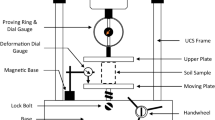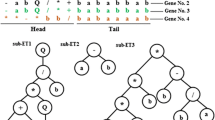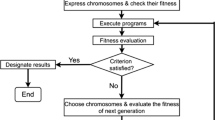Abstract
The creep index plays an important role in calculating the long-term settlement of natural soft clays, so it is vital to determine the creep index quickly and accurately. However, the prediction accuracy of the existing creep index models is low. This study presents seven gene expression programming (GEP) models by using different combinations of the liquid limit wL, plasticity index Ip, void ratio e and clay content CI as input variables for the prediction of creep index. A total of 151 datasets were collected from the available literature for building and testing the GEP models. The proposed GEP models were compared with two machine learning (ML) models (i.e., back propagation neural network and random forest) and five conventional empirical models in terms of three statistical indicators. The research results showed that the prediction performances of the two proposed GEP models (i.e., with combinations \(CI{-}w_{L} {-}e\) and \(CI{-}I_{p} {-}w_{L} {-}e\) as input, respectively) surpass those of the five conventional empirical models and two ML-based models, recommended for predicting the creep index of natural soft clays in engineering practice.














Similar content being viewed by others
Data availability
Data will be made available on reasonable request.
References
Breiman L (2001) Random forests. Mach Learn 45:5–32
Fattahi H (2017) Prediction of slope stability using adaptive neuro-fuzzy inference system based on clustering methods. J Min Environ 8(2):163–178
Ferreira C (2001) Gene expression programming: a new adaptive algorithm for solving problems. Complex Syst 13(2):87–129
Ferreira C (2006) Gene expression programming: mathematical modeling by an artificial intelligence. Biswas Hope press, Canada, pp 223–225
Gordan B, Armaghani DJ, Hajihassani M, Wroblewski P (2016) Prediction of seismic slope s tability through combination of particle swarm optimization and neural network. Eng Comput Ger 32:85–97
Jafari S, Mahini SS (2017) Lightweight concrete design using gene expression programing. Constr Build Mater 139:93–100
Jong SC, Ong DEL, Oh E (2021) State-of-the-art review of geotechnical-driven artificial intelligence techniques in underground soil-structure interaction. Tunn Undergr Space Technol 113:103946
Karstunen M, Yin ZY (2010) Modelling time-dependent behavior of Murro test embankment. Geotechnique 60(10):735–749
Koopialipoor M, Armaghani DJ, Hedayat A, Maarto A (2019) Applying various hybrid intelligent systems to evaluate and predict slope stability under static and dynamic conditions. Soft Comput 23(14):5913–5929
Meng FY, Chen RP, Xin K (2018) Effects of tunneling-induced soil disturbance on the post-construction settlement in structured soft soils. Tunn Undergr Space Technol 80:53–63
Murad Y, Ashteyat A, Hunaifat R (2019) Predictive model to the bond strength of FRP-to concrete under direct pullout using gene expression programming. J Civ Eng Manag 25(8):773–784
Nakase A, Kamei T, Kusakabe O (1988) Constitutive parameters estimated by plasticity index. Chin J Geotech Eng 114(7):844–858
Nakase A, Kamei T, Kusakabe O (1998) Constitutive parameters estimated by plasticity index. J Geotech Eng 114:844–858
Sharma S, Ahmed S, Naseem M, Alnumay W, Singh S, Cho GH (2021) A survey on applications of artificial intelligence for pre-parametric project cost and soil shear-strength estimation in construction and geotechnical engineering. Sensors 21(2):463–506
Shen SL, Wu HN, Cui YJ, Yin ZY (2014) Long-term settlement behaviour of metro tunnels in the soft deposits of Shanghai. Tunn Undergr Space Technol 40:309–323
Sun YB, Wendi D, Kim DE (2016) Application of artificial neural networks in groundwater table forecasting-a case study in a Singapore swamp forest. Hydrol Earth Syst Sci 20:1405–1412
Tan F, Zhou WH, Yuen KV (2018) Effect of loading duration on uncertainty in creep analysis of clay. Int J Numer Anal Methods Geomech 42:1235–1254
Xiong LH, Kieran MO, Guo SL (2004) Comparasion of three updating schemes using artificial neural network in flow forecasting. Hydrol Earth Syst Sci 8(2):247–255
Xue XH (2017) Prediction of daily diffuse solar radiation using artificial neural networks. Int J Hydrog Energy 42:28214–28221
Yang B, Yin K, Lacasse S, Liu Z (2019) Time series analysis and long short-term memory neural network to predict landslide displacement. Landslides 16:677–694
Yin JH (1999) Properties and behavior of Hong Kong marine deposits with different clay contents. Can Geotech J 36:1085–1095
Yin ZY, Chang CS (2009) Microstructural modeling of stress-dependent behavior of clay. Int J Solids Struct 46:1373–1388
Yin ZY, Chang CS, Karstunen M, Hicher PY (2010) An anisotropic elastic-viscoplastic model for soft clays. Int J Solids Struct 47:665–677
Yin ZY, Xu Q, Yu C (2014a) Elastic-viscoplastic modeling for natural soft clays considering nonlinear creep. Int J Geomech 15(5):1–10
Yin ZY, Yin JH, Huang HW (2015) Rate-dependent and long-term yield stress and strength of soft Wenzhou marine clay: experiments and modeling. Mar Georesour Geotechnol 33:79–91
Yin ZY, Zhu QY, Yin JH, Ni Q (2014b) Stress relaxation coefficient and formulation for soft soils. Geotech Lett 4:45–51
Yin ZY, Zhu QY, Zhang DM (2017) Comparison of two creep degradation modeling approaches for soft structured soils. Acta Geotech 12:1395–1413
Zeng LL, Hong ZS, Liu SY, Chen FQ (2012) Variation law and quantitative evaluation of secondary consolidation behavior for remolded clays. Chin J Geotech Eng 34:1496–1500
Zhang CS, Ji J, Gui YL, Kodikara J (2016) Evaluation of soil-concrete interface shear strength based on LS-SVM. Geomech Eng 11(3):361–372
Zhang P, Yin ZY, Jin YF, Chan THT (2020) A novel hybrid surrogate intelligent model for creep index prediction based on particle swarm optimization and random forest. Eng Geol 265:1–12
Zhang WG, Li HR, Li YQ, Liu HL, Chen YM, Ding XM (2021) Application of deep learning algorithms in geotechnical engineering: a short critical review. Artif Intell Rev 54:5633–5673
Zhu QY, Yin ZY, Hicher PY, Shen SL (2016) Nonlinearity of one-dimensional creep characteristics of soft clays. Acta Geotech 11:887–900
Zhu QY, Jin YF, Yin ZY (2020) Modeling of embankment beneath marine deposited soft sensitive clays considering straightforward creep degradation. Mar Georesour Geotechnol 38(5):553–569
Funding
The authors have not disclosed any funding.
Author information
Authors and Affiliations
Contributions
XX: Methodology, Data acquisition, Writing—original draft. CD: Software, Numerical analysis.
Corresponding author
Ethics declarations
Conflict of interest
The authors declare that they have no known competing financial interests or personal relationships that could have appeared to influence the work reported in this paper.
Additional information
Publisher's Note
Springer Nature remains neutral with regard to jurisdictional claims in published maps and institutional affiliations.
Rights and permissions
Springer Nature or its licensor (e.g. a society or other partner) holds exclusive rights to this article under a publishing agreement with the author(s) or other rightsholder(s); author self-archiving of the accepted manuscript version of this article is solely governed by the terms of such publishing agreement and applicable law.
About this article
Cite this article
Xue, X., Deng, C. Prediction of creep index of soft clays using gene expression programming. Soft Comput 27, 16265–16278 (2023). https://doi.org/10.1007/s00500-023-08053-8
Accepted:
Published:
Issue Date:
DOI: https://doi.org/10.1007/s00500-023-08053-8




